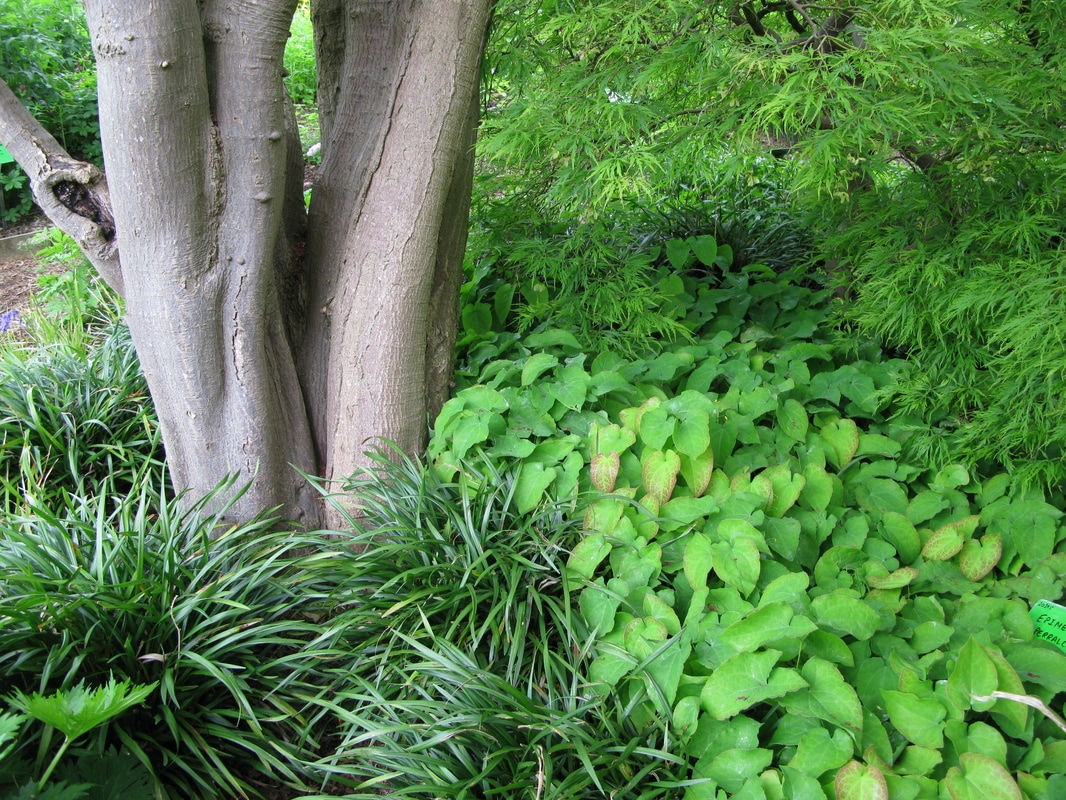|
As labels go, 'ground cover' doesn't rank high for excitement. It sounds utilitarian: soaking up pollution in car-parks, or hiding parts of the garden you can't do anything with. But its name belies its potential loveliness. Ground cover plants survive and even thrive in challenging situations. This can apply, for instance, to the ground below deciduous trees. Trees can take up most of the moisture and nutrients from the soil, and cast shade for much of the year. In the photos above and below, a bed of fine-leaved Acers is underplanted with evergreen Epimedium, Lirope and Ophiopogon. Tough, spreading, tolerant of dry shade, these are good choices from a horticultural perspective. In terms of design, limiting the scheme to three key plants ties into the Japanese aesthetic of beauty in simplicity. And it works all year round - the photos here were taken in Autumn, Winter and Spring. It's a lovely example of thoughtful planting design. As with Ophiopogon planiscapus 'Nigresens' - a rich blue-black all year round - evergreens are not necessarily always green. Certain varieties of Bergenia colour up in reds and purples as the weather cools, as do some Epimediums, whose new growth is often flushed red or bronze. Ajuga reptans comes in a few different varieties of purples from pink to bronze, all with very pretty blue flowers in Spring. It spreads enthusiastically by stolons - I don't think I've bought one for years, but propagated many - but is easy to pull up when it's travelled too far, and is always keenly accepted as a gift. Ground cover planting doesn't have to be evergreen either. Some geraniums will indeed keep their leaves all year round (e.g. the cranesbills), and there are plenty of deciduous perennial geraniums will come into leaf in the Spring and last into late Autumn, with a good few months of colourful flowering in between. Many deciduous ornamental grasses will shoot up quickly in Spring, and still look attractive when faded, until they are cut back in late Winter. And then there are prolifically successful perennials such as Lady's Mantle - Alchemilla mollis - that will fill out fast in a herbaceous border. Deciduous ground cover fills space and suppresses weeds successfully in the warmer months, but remember that they will leave bare patches in Winter. If bare patches won't do, a combination of evergreen, semi-evergreen and deciduous planting will deliver richness of texture plus Spring and Summer flowering. In the images below, vigorous growers such as Alchemilla mollis, Erigeron karvanskias, Pulmonaria and Astrantia fill out quickly and then reduce or disappear at the end of the season. Evergreen Bergenia, Pachysandra terminalis and Hebe rakaiensis then hold the fort for the rest of the Winter. Whatever you need your ground cover to do, fortunately there is plenty of choice. Sometimes you need to cover a bare area of earth as quickly as possible, either to prevent weeds taking hold, or perhaps where the soil is fragile and may slip or erode. Sometimes you just want to hold a corner, or to soften the edge of hard-landscaping. Whether in sun or shade, damp or dry soil, there will be a plant willing to take on the job. Once you're sorted for your difficult horizontal surfaces, you might find your eye wandering upwards. For softening the corners of buildings, a combination of evergreen ground cover and wall shrubs can be really beautiful, as in the image above. But I digress - I'll leave walls for another day and another blog.
0 Comments
Your comment will be posted after it is approved.
Leave a Reply. |
AuthorCaroline Butler is a garden designer based in Bristol Archives
October 2018
Categories |















